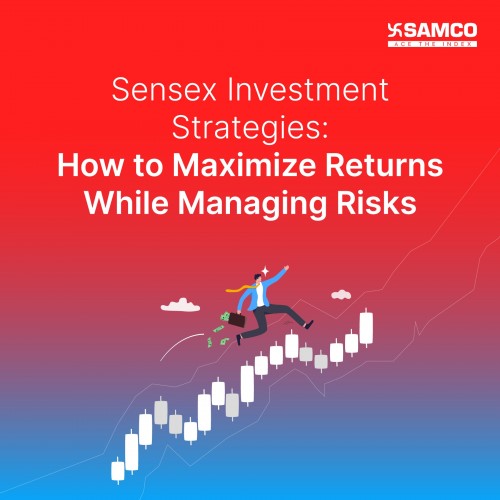Sensex Investment Strategies: How to Maximize Returns While Managing Risks

The S&P BSE Sensex is an indicator of the performance of the Bombay Stock Exchange (BSE) in India's stock market. It is a leading indicator of the state of the Indian economy and one of the most watched indexes on the stock market. The Sensex is a potentially rewarding investment but carries a high degree of risk. So, to get the most out of your investments while minimizing your risk exposure, you need a solid plan.
This piece aims to serve as an all-inclusive resource for Sensex investing methods. Many investing options, methods for maximizing profits while minimizing losses and typical pitfalls will all be discussed. The tactics discussed may be applied in practice, and the essay will include case studies of successful Sensex investors to show how.
Understanding Sensex and its Performance
The Sensex debuted on January 1, 1986, with a base value of 100. It comprises 30 of the most actively traded equities on the Bombay Stock Exchange (BSE). Stocks are chosen based on market capitalization, liquidity, and trading volume. The Sensex's composition is revised regularly to ensure it appropriately represents current market circumstances.
Key Performance Indicators of Sensex
Sensex's key performance indicators (KPIs) are used to measure its performance. The most commonly used KPIs are the index level, daily change, percentage change, and market capitalization. The index level reflects the current value of Sensex, while the daily change and percentage change show the increase or decrease in the index's value over a specified period. On the other hand, market capitalization is the total value of all the stocks in the index.
Factors Affecting Sensex Performance
A variety of factors, including economic, political, and social factors, influence the performance of Sensex. Economic factors such as GDP growth, inflation, interest rates, and corporate earnings can significantly impact Sensex's performance. Political factors such as government policies, elections, and global events can also influence the index's performance. Social factors such as changes in consumer behavior, demographic trends, and cultural shifts can also affect Sensex's performance.
In recent years, the COVID-19 pandemic has had a significant impact on Sensex's performance, causing significant volatility in the market. Investors need to understand these factors and how they can impact Sensex's performance to make informed investment decisions. By monitoring the key performance indicators and keeping abreast of the latest market news, investors can better understand Sensex's performance and make informed investment decisions.
Types of Sensex Investment Strategies
Investors use various strategies to invest in the Sensex to maximize their returns while managing risks. Here are three primary types of Sensex investment strategies:
Fundamental Analysis
Fundamental analysis is analyzing a company'fsinancial and economic data to determine its intrinsic value. It is based on the premise that a company's stock price is driven by its underlying business fundamentals, such as earnings, revenue, cash flow, and assets. Fundamental analysis involves researching the company's financial statements, earnings reports, and other market data to determine the company's financial health, growth potential, and market position.
Key Components and Metrics
* Balance Sheet: provides information on a company's assets, liabilities, and equity.
* Income Statement: shows a company's revenue, expenses, and net income.
* Cash Flow Statement: displays the cash inflows and outflows of a company.
* P/E Ratio: measures a company's current stock price relative to its earnings per share.
* P/B Ratio: compares a company's market capitalization to its book value.
* Dividend Yield: shows the percentage of return on dividends relative to a stock's price.
Advantages
* Provides a comprehensive view of a company's financial health, growth potential, and market position.
* Helps investors understand the intrinsic value of a company's stock by analyzing its financial statements.
* Can identify stocks that may be undervalued or overvalued, providing potential trading opportunities.
Disadvantages
* Time-consuming, as it requires extensive research and analysis.
* Requires expertise and knowledge to perform effectively, making it challenging for novice investors.
* Can be impacted by external factors, such as changes in the economic or political environment that may not be reflected in a company's financial statements.
Technical Analysis
Technical analysis is a method of analyzing stock prices and market data to identify trends and patterns. It involves using charts, graphs, and other tools to analyze market data and identify potential trading opportunities. Technical analysis is based on the premise that market trends and patterns drive stock prices and that these trends and patterns can be used to predict future price movements.
Key Metrics
* Moving Averages: used to identify trends by smoothing out price fluctuations over a set time period.
* Trend Lines: used to identify potential support and resistance levels.
* Momentum Indicators: show the rate of change in a stock's price over time.
* Relative Strength Index (RSI): measures the magnitude of recent price changes to evaluate whether a stock is overbought or oversold.
* Bollinger Bands: uses moving averages and standard deviations to identify potential buy or sell signals based on a stock's volatility.
Advantages
* Can identify short-term trading opportunities based on patterns and trends in a stock's price data.
* Can be used to determine potential buy or sell signals based on historical data.
* Provides a visual representation of a stock's price movements, making it easy to interpret and analyze.
* Can be automated, allowing for faster and more accurate analysis.
Disadvantages
* Does not take into account fundamental factors such as a company's financial health or growth potential.
* Can be impacted by unexpected events or news that may not be reflected in a stock's historical price data.
* Can be prone to false signals and errors, leading to potential losses.
* Can be influenced by subjective interpretations and biases.
Quantitative Analysis
Quantitative analysis uses statistical models and mathematical algorithms to analyze market data and identify potential trading opportunities. It involves using complex algorithms and models to analyze large amounts of market data and identify patterns and trends that are invisible to the naked eye.
Key Metrics
* Price Volatility: measures the amount and frequency of price changes in stock.
* Trading Volume: shows the number of shares traded during a specific time period.
* Correlation: measures the relationship between two or more stocks.
* Regression Analysis: uses historical data to estimate future trends.
* Neural Networks: uses machine learning algorithms to identify patterns in stock price data.
* Decision Trees: helps identify potential trading opportunities by classifying data into different categories.
Advantages
* Provides objective and data-driven insights into a stock's performance.
* Can be used to develop trading algorithms and models that can automate investment decisions.
* Helps identify patterns and trends that may not be apparent through fundamental or technical analysis.
* Allows for more accurate risk management and portfolio optimization.
Disadvantages
* Requires access to large amounts of historical data and sophisticated tools for analysis, making it costly for individual investors.
* Can be impacted by unexpected events or anomalies in data that may not be reflected in the model.
* May oversimplify complex market dynamics and fail to capture important factors that impact stock performance.
Best Practices for Maximizing Returns and Managing Risks
Investing in the stock market can be a rewarding experience, but it can also be risky. To maximize returns while managing risks, investors must adopt best practices to help them navigate the market's ups and downs. Here are some of the best practices for maximizing returns and managing risks:
Diversification
Diversification is the practice of investing in a variety of stocks across different sectors, geographies, and asset classes. Diversification helps reduce a portfolio's overall risk by spreading investments across multiple assets. When one asset class or sector performs poorly, the other assets in the portfolio can help offset those losses.
Strategies for Diversification
- Invest in different sectors: One of the simplest ways to diversify is to invest in stocks from different sectors. For example, suppose an investor has a portfolio that includes stocks from the technology, healthcare, and financial sectors. In that case, a downturn in one sector may be offset by gains in another.
- Invest in different asset classes: Investors can also diversify by investing in different asset classes, such as stocks, bonds, and commodities. By spreading investments across different asset classes, investors can reduce the overall risk of their portfolio.
- Choose regions to invest in: Investing in stocks from different countries is another way to diversify. This can provide exposure to different economies and currencies, reducing the risk of being overly exposed to any one country.
- Invest in index funds or ETFs: Index funds and ETFs provide a convenient way to diversify. These funds track a specific index or sector and invest in a basket of stocks, providing exposure to a diversified group of companies.
Risk Management
Risk management is the practice of identifying, assessing, and controlling risks. Investors need to understand the risks associated with their investments and take measures to mitigate them. Risk management strategies can include diversification, setting stop-loss orders, and using hedging strategies such as options or futures contracts.
Risk Management Strategies
- Set investment goals and risk tolerance: Before investing, it is important to determine investment goals and risk tolerance. This will help investors understand how much risk they are comfortable taking and what level of return they expect from their investments.
- Use stop-loss orders: Stop-loss orders can help limit potential losses by automatically selling a stock when it reaches a predetermined price. This can help prevent further losses if stock continues to decline.
- Keep an eye on market trends: Investors should keep track of market trends and news that could affect their investments. This can help them make informed decisions and adjust their investment strategy as needed.
- Regularly review and rebalance the portfolio: It is essential to regularly review the portfolio and make adjustments to maintain the desired level of risk. This may include rebalancing the portfolio by selling stocks performing well and investing in those underperforming.
- Avoid herd mentality: It is important to avoid making investment decisions based solely on what everyone else is doing. The herd mentality can lead to poor investment decisions, such as buying high and selling low.
Long-term Perspective
Investing in the stock market requires a long-term perspective. Stocks can be volatile in the short term, but they tend to provide higher returns over the long term than other asset classes, such as bonds or cash. Investors should adopt a long-term perspective and resist the urge to make frequent trades based on short-term fluctuations in the market.
- Compounding returns: Taking a long-term perspective allows investors to benefit from the compounding effect of returns over time. This means that as returns are reinvested, they generate additional returns, which can significantly increase the overall investment return.
- Reduced volatility: The longer an investment is held, the less impact short-term market fluctuations have on its value. This can help reduce volatility in a portfolio and minimize the impact of market downturns.
- More time to recover from losses: Long-term investors have more time to recover from any losses they may experience. This means they can ride out market fluctuations and wait for the market to recover rather than selling at a loss and missing out on potential future gains.
- Less frequent trading: Taking a long-term perspective means that investors are less likely to engage in frequent trading, which can lead to higher transaction costs and lower returns. Instead, they can focus on investing in quality companies likely to perform well over the long term.
- Tax benefits: Holding an investment for the long term can also provide tax benefits, as long-term capital gains are taxed at a lower rate than short-term gains.
Conclusion
In conclusion, having a sound investment strategy is crucial when investing in the Sensex to maximize returns while managing risks. This article has covered various investment strategies, including fundamental analysis, technical analysis, and quantitative analysis, along with best practices for diversification, risk management, taking a long-term perspective, and maintaining discipline and patience.
However, developing and implementing an investment strategy can be challenging, especially for beginners. This is where Samco, a leading trading app, comes in to help investors achieve their financial goals. Samco offers a range of tools and resources to help investors make informed investment decisions and easily manage their investments. With it, investors can access advanced trading tools, market research, and expert advice to stay ahead of the curve.Samco’s mission is to help every stock market participant to consistently Ace the Index and achieve their best financial performance.


















